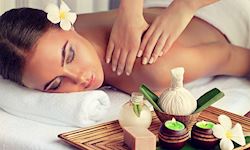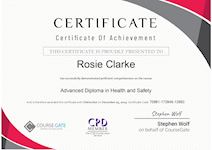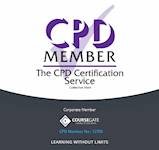Aromatherapy, Holistic & Massage Therapy Course
Exam Included . CPD Accredited Qualification . Lifetime access . Immediate Result
Course Gate
Summary
- Tutor is available to students
Overview
Aromatherapy, Holistic & Massage Therapy Course is suitable for anyone aspiring to or already working in this field or simply want to learn deeper into Aromatherapy, Holistic & Massage Therapy Course.
To make this course more accessible for you, we have designed it for both part-time and full-time students. This course is packed into bite-size module for your convenience. You can study at your own pace or become accredited within hours!
If you require support, our experienced tutors are always available to help you throughout the comprehensive syllabus of this course and answer all your queries through email
Welcome to Aromatherapy, Holistic & Massage Therapy Course.
It is not a secret anymore that Aromatherapy helps people to defeat physiological issues. Aromatherapy treatments primarily incorporate massage, topical applications, and inhalation. The course introduces you with the benefits of Aromatherapy, Holistic & Massage Therapy that use essential oils and other aromatic plant composites. You will learn the skills for massaging, including different kinds of massage techniques and grasp the art of massage therapy. Furthermore, understand how aromatherapy can practice as the treatment to relieve or heal various shambles.
Additionally, the course mentions a range of essential oils that have been used to relief from pain or for relaxation.
Course media
Description
What will you learn in this Aromatherapy, Holistic & Massage Therapy Course
Module 1
In this module you will learn all about Introduction to Massage Therapy. The word Massage is a derivation from the Greek massein, or the French masser, which both mean: to knead. A male operator is called a masseur, a female operator, a masseuse.Massage is a scientific treatment, by certain passive systematic manipulations, upon the nude skin of the human body.Massage involves working and acting on the body with pressure – structured, unstructured, stationary, or moving – tension, motion, or vibration.
Module 2
This module will teach you about Massage History. Archaeological evidence of massage has been found in many ancient civilizations including China, India, Japan, Korea, Egypt, Rome, Greece, and Mesopotamia.BC 2330: The Tomb of Akmanthor (also known as “The Tomb of the Physician”) in Saqqara, Egypt depicts two men having work done on their feet and hands, presumably massage.BC 722-481: Huangdi Neijing is composed during the Chinese Spring and Autumn period (the beginning of recorded history).
Module 3
In this module you will learn all about The Role of A Massage Therapist. Massage therapists can be employed to do a number of other things besides the ones listed above. It can be used to relieve pain from arthritis and it can be used for therapy for people that have paralysis on their body. It can be used to relieve chronic tension symptoms other than muscle tension. The benefits for people opting for this type of therapy include circulation improvement, increased joint flexibility, and reduction of fatigue in your body and also from a mental standpoint.
Module 4
This module will teach you about Tissues, Organs, & Neuromuscular systems. The function of an organ system depends on the integrated activity of its organs. For instance, digestive system organs cooperate to process food.The survival of the organism depends on the integrated activity of all the organ systems, often coordinated by the endocrine and nervous systems.
Module 5
In this module you will learn all about General Benefits of Massage. mechanical responses as a result of pressure and movement as the soft tissues are manipulated reflex responses in which the nerves respond to stimulation.
Module 6
This module will teach you about Indian Head Massage. Indian Head Massage is an integral part of the Ayurvedic healing system that originated in India, millennia ago, and has been passed down through generations. The art was developed by and for women in India with the aim of stimulating long, healthy hair. Narendra Mehta introduced Indian Head Massage to the West in the 1970s when he came to the UK to study physiotherapy. While living in England, he realised that nobody was practicing Indian Head Massage.
Module 7
In this module you will learn all about Facial Massage. Facial massages increase circulation to your facial tissue, resulting in brighter, youthful-looking skin. Facial massages can also help to lift and firm the skin, reducing the appearance of puffiness and wrinkles. As an added benefit, a good facial massage reduces stress, leaving you feeling peaceful and relaxed. Treat yourself to a massage once a day, either in the morning or at night before you go to sleep.
Module 8
This module will teach you about Neck Massage. Stress is a common cause of neck and back pain. When we are under stress, we tend to raise our shoulders toward our ears and hunch forward, which puts strain on the back of the neck and the shoulders. The muscles that control the neck and shoulders all originate on the base of the skull and insert either on the head of the humerus, the clavicle, the scapula or the spine, depending on function. A gentle neck massage can reverse and relieve the effects of stress.
Module 9
In this module you will learn all about Back Massage is one of the types of a massage therapy that clients enjoy the most, and need the most. It is the area clients often request extra time toward, some even request the entire hour of massage be given just on the back muscles.
Module 10
This module will teach you about Full Body Massage. A full-body massage indicates that the therapist will massage your whole body during a therapeutic massage lasting at least 50 minutes. That’s the amount of time needed to massage all the major areas of your body – back, shoulders, legs, feet, arms, hands and neck. Men get a nice pectoral massage, but women have to go to Europe for that.You generally start face down and the massage therapist starts with your back and shoulder, then moves down the body.
Module 12
In this module you will learn all about Swedish Massage. Swedish massage therapy is the modality that comes to mind when most people think about massage. As the best-known type of bodywork performed today, one of the primary goals of the Swedish massage technique is to relax the entire body. This is accomplished by rubbing the muscles with long gliding strokes in the direction of blood returning to the heart. But Swedish massage therapy goes beyond relaxation.
Module 13
This module will teach you about Sports Massage. Sports massage is a form of massage involving the manipulation of soft tissue to benefit a person engaged in regular physical activity. Soft tissue is connective tissue that has not hardened into bone and cartilage; it includes skin, muscles, tendons, ligaments and fascia (a form of connective tissue that lines and ensheathes the other soft tissues). Sports massage is designed to assist in correcting problems and imbalances in soft tissue that are caused from repetitive and strenuous physical activity and trauma.
Module 14
In this module you will learn all about LomiLomi Massage.
Lomilomi is the word used today to mean “massage therapist” or “Hawaiian massage.” In the Hawaiian language, the word used traditionally, called lomi, means “to knead, to rub, or soothe; to work in and out, as the paws of a contented cat. Lomilom i is a traditional Hawaiian massage that uses a combination of massage techniques, nut oils, and sometimes elements of prayer, breathing and dance to restore energy and soothe the body.
Module 15
This module will teach you about Anti-Cellulite Massage.This hands-on treatment uses stroking, kneading and rhythmic motions to loosen fatty tissues and smooth out the skin’s surface. By releasing the areas where cellulite most commonly appears, the body’s natural healing process is engaged. This can boost blood circulation and collagen production.
Module 16
In this module you will learn all about Hot stone massage incorporates heated stones as part of the therapy. The massage therapist will use the smooth stones as either an extension of their hands or by placing them on the body. The stones are typically very smooth-surfaced basalt stones, in which the high iron content in basalt helps the stones retain heat during the massage.
Method of Assessment:
Upon completion of the course, you will be required to sit for an online multiple-choice quiz based assessment, which will determine whether you have passed the course (60% pass mark). The test will be marked immediately and results will be published instantly.
Certification
After successfully completing the course, you will be able to obtain the certificates. You can claim a PDF certificate by paying a little processing fee of £2. There is an additional fee to obtain a hardcopy certificate which is £9.
Who is this course for?
Aromatherapy, Holistic & Massage Therapy Course is suitable for anyone who want to gain extensive knowledge, potential experience and professional skills in the related field.
Requirements
Our Aromatherapy, Holistic & Massage Therapy Course is open to all from all academic backgrounds and there is no specific requirements to attend this course. It is compatible and accessible from any device including Windows, Mac, Android, iOS, Tablets etc.
Career path
This course opens a new door for you to enter the relevant job market and also gives you the opportunity to acquire extensive knowledge along with required skills to become successful. You will be able to add our qualification to your CV/resume which will help you to stand out in the competitive job industry.
Questions and answers
Currently there are no Q&As for this course. Be the first to ask a question.
Reviews
Currently there are no reviews for this course. Be the first to leave a review.
Legal information
This course is advertised on reed.co.uk by the Course Provider, whose terms and conditions apply. Purchases are made directly from the Course Provider, and as such, content and materials are supplied by the Course Provider directly. Reed is acting as agent and not reseller in relation to this course. Reed's only responsibility is to facilitate your payment for the course. It is your responsibility to review and agree to the Course Provider's terms and conditions and satisfy yourself as to the suitability of the course you intend to purchase. Reed will not have any responsibility for the content of the course and/or associated materials.




